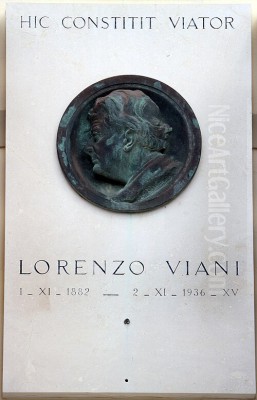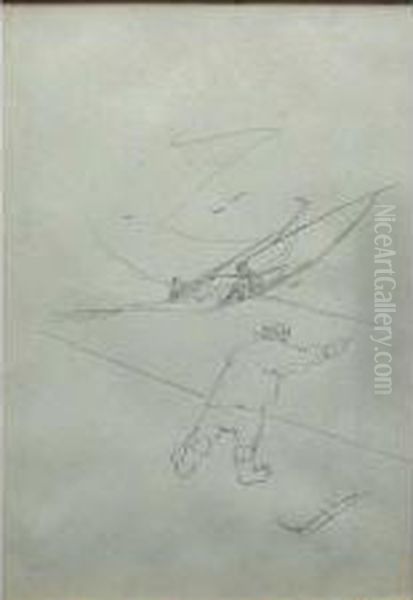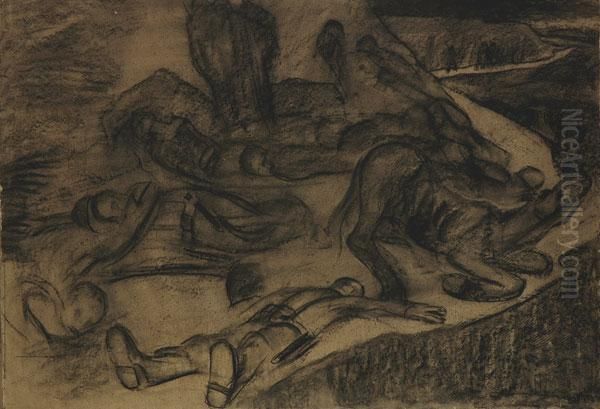
Lorenzo Viani stands as a significant figure in early 20th-century Italian art. Born in the coastal town of Viareggio in 1882 and passing away in Lido di Ostia in 1936, Viani was a multifaceted talent – a painter, sculptor, and writer whose work resonated with the raw energy of Expressionism and a deep-seated concern for the marginalized segments of society. His art provides a powerful, often unsettling, glimpse into the lives of the poor, the labourers, and the outcasts of his native Versilia region, rendered with a distinctive style that drew from both Northern European and Italian traditions.
Viani's artistic identity was intrinsically linked to Viareggio, the Tuscan seaside town where he spent his formative years. The sights, sounds, and struggles of this community, particularly its fishermen and shipyard workers, would become recurring motifs throughout his career. His connection to this specific locale provided an anchor for his explorations of universal human themes: suffering, poverty, resilience, and the search for dignity amidst hardship.
Early Life and Artistic Formation
Lorenzo Viani's journey into the art world was not one of traditional academic privilege. Born into a family connected to the service of the Bourbon-Parma royals, his path diverged early on. He gained initial artistic experience working as an apprentice for local decorators. His formal training included studies at the Institute of Fine Arts in Lucca, where he likely encountered the foundational principles of drawing and painting. He continued his studies in Florence and later Genoa, absorbing the artistic currents circulating in these more prominent cultural centres.
However, Viani's most profound influences seem to have come from beyond the confines of Italian classicism. He was deeply affected by the emotional intensity and stylistic innovations of Northern European Expressionism. Artists like Norway's Edvard Munch, with his haunting depictions of psychological angst, and perhaps the Belgian master James Ensor, known for his grotesque masks and socially critical works, appear to have left a mark on Viani's developing vision. Furthermore, he found inspiration in the stark linearity and expressive power of French medieval Gothic illustrations and woodcuts, appreciating their directness and narrative force.

This blend of influences – the raw emotion of Expressionism, the narrative clarity of Gothic art, and his own lived experiences in Viareggio – coalesced into a unique artistic voice. He was less interested in idealized beauty and more focused on capturing the unvarnished truth of human existence, particularly for those living on the fringes.
The Expressionist Vision
Expressionism formed the core of Lorenzo Viani's artistic language. He embraced its tenets wholeheartedly, using distorted forms, agitated brushwork, and non-naturalistic colours to convey intense emotions and subjective experiences. His goal was not merely to represent reality but to express the inner turmoil, the suffering, and the raw vitality he perceived in the world around him, particularly among the working classes and the poor.
His paintings often feature figures with exaggerated features, their bodies sometimes appearing gaunt or contorted by hardship or psychological distress. Lines are bold and dynamic, often appearing rapidly applied, contributing to a sense of urgency and raw energy. Viani's palette was equally expressive, favouring strong, often somber, colour contrasts. He frequently employed blues and greens, not just for descriptive purposes, but for their symbolic weight, using them to evoke moods of melancholy, poverty, or even the presence of death.
A pivotal early work showcasing this burgeoning style is La Peste a Lucca (The Plague in Lucca), created around 1907. This dramatic composition depicts the historical trauma of the Black Death with a visceral intensity. The figures are stylized, almost spectral, rendered in unsettling blues and greens against a stark background. The work demonstrates Viani's assimilation of Northern Expressionist and Gothic influences, creating a powerful image of collective suffering and mortality that transcends its historical setting. This painting, while admired for its power, also sparked debate regarding its subjective and emotionally charged use of colour.
Themes of the Marginalized
Central to Viani's oeuvre was his unwavering focus on the lives of the marginalized. He turned his artistic gaze towards the fishermen battling the sea, the quarry workers toiling in the Apuan Alps near Versilia, the destitute inhabitants of poorhouses, and even those confined to mental asylums. These were not subjects chosen for picturesque effect; they were chosen out of a profound sense of empathy and social conscience.

Viani depicted these individuals with a stark realism that avoided sentimentality. He portrayed their physical hardships, the weariness etched on their faces, and the often-bleak environments they inhabited. Works like Albergo dei Poveri (Poorhouse) directly confront the viewer with the realities of poverty, contrasting the indifference of society with the quiet desperation or flickering hope of the impoverished. His numerous depictions of fishermen (Pescatore) capture the ruggedness and inherent danger of their profession, celebrating their resilience while acknowledging their vulnerability.
This focus on the underclass was likely fueled by Viani's own political leanings, which are often described as aligning with anarchist and socialist ideals. He saw in these marginalized figures not just victims of circumstance, but individuals possessing a raw, authentic humanity often absent in bourgeois society. His art became a platform to give voice to the voiceless, challenging societal indifference and highlighting the dignity inherent in struggle. His connection to the Versilia region was crucial; he painted the people he knew, grounding his social commentary in lived experience.
Woodcuts and Graphic Work
Beyond painting, Lorenzo Viani made significant contributions to the art of the woodcut in Italy. This medium, with its potential for strong contrasts, bold lines, and inherent rawness, perfectly suited his Expressionist temperament and his subject matter. He embraced the technique not just as a means of reproduction, but as a primary form of artistic expression.
In 1915, he published a significant series of woodcuts titled L'Eroica. This collection exemplified his interest in what could be termed a form of Neo-Primitivism – a desire to return to a more direct, unadorned, and emotionally authentic form of expression, stripping away academic polish. The woodcuts in L'Eroica are characterized by their stark black-and-white contrasts, simplified forms, and powerful, sometimes brutal, energy. They often depict the familiar themes of labour, poverty, and the sea, rendered with an immediacy that is deeply affecting.
Other notable graphic works include La benedizione dei morti del mare (The Blessing of the Dead of the Sea), a poignant woodcut addressing the perils faced by seafaring communities. His graphic output demonstrated his mastery of line and contrast, proving that powerful emotional statements could be made with seemingly simple means. Viani's work in this field is considered crucial to the revival and modernization of the woodcut in Italy during the early 20th century, placing him among the key figures who explored the expressive potential of printmaking. Some art historians connect his work to broader European trends in graphic arts, sometimes referring to movements aiming to revitalize the medium, akin to a "Woodcut Secession" from purely academic constraints.
War and its Aftermath
The cataclysm of the First World War (1914-1918) inevitably impacted Lorenzo Viani, as it did countless artists across Europe. He served in the Italian army during the conflict, experiencing firsthand the brutality and suffering of modern warfare. This experience appears to have deepened his existing preoccupation with human suffering, mortality, and the struggles of ordinary people caught in forces beyond their control.
His work from this period and immediately after reflects this trauma. In 1917, he created La Guerra (War), a piece that directly confronts the conflict's devastating impact. While details of this specific work might vary, his art generally took on an even starker, more somber tone. The war likely reinforced his disillusionment with established societal structures and intensified his empathy for those who bore the brunt of the violence – the common soldiers, the bereaved families, the displaced.
The war years and their aftermath saw Viani continue to refine his expressive language. The themes of death, loss, and resilience, already present in his pre-war work, gained a new layer of urgency and gravitas. The conflict provided a grim, large-scale confirmation of the hardships he had long observed on a smaller, more localized scale in Versilia. His art became a testament not only to the struggles of the poor but also to the broader human condition in an age marked by unprecedented violence.
Connections and Contemporaries
Lorenzo Viani did not create in isolation. He was part of the vibrant, often tumultuous, Italian art scene of the early 20th century. His engagement with various movements and his relationships with other artists, whether collaborative or competitive, shaped his trajectory.
His participation in a 1915 Milan exhibition associated with Futurism indicates his awareness of, and temporary engagement with, this radical avant-garde movement. While Viani's core concerns differed from the Futurist obsession with speed, machines, and the destruction of tradition championed by figures like Filippo Tommaso Marinetti and artists such as Umberto Boccioni, he shared their desire to break from academic constraints and find new, dynamic forms of expression. He certainly knew the work of key Futurists like Carlo Carrà, who himself moved through various stylistic phases.
Viani's Expressionism places him in a broader European context alongside Munch and Ensor. While perhaps less internationally famous during his lifetime, his work shares their emotional intensity and focus on subjective experience. One might also consider parallels, though perhaps indirect, with the emotional use of colour and brushwork found in the work of Vincent van Gogh.
Within Italy, Viani's focus on expressive figuration can be contrasted with other contemporaries. Amedeo Modigliani, though working primarily in Paris, created stylized and emotionally resonant portraits. The Metaphysical painting of Giorgio de Chirico offered a completely different path, exploring dreamlike, enigmatic cityscapes. Later, artists like Mario Sironi would also tackle social themes, but often with a more monumental, state-inflected style, particularly during the Fascist era. The precise, sometimes unsettling realism of Felice Casorati provides another point of contrast within the diverse landscape of Italian modernism.
Viani was also reportedly connected with friends of the writer and poet Gabriele D'Annunzio, collaborating in depicting the life and poverty of the Versilia region. Later in his career, Viani even showed an awareness of Surrealism, drawing inspiration from the imaginative and psychologically charged works of artists like Salvador Dalí and René Magritte, adapting elements into his own distinct visual language. He is also mentioned alongside artists like Ugo Piacentini, indicating his participation in the networks and exhibitions of the time. These connections highlight Viani's position within a dynamic artistic milieu, absorbing influences while forging his own unique path.
Later Career and Evolution
Throughout the 1920s and into the 1930s, Lorenzo Viani remained a prolific artist, dividing his time primarily between his native Viareggio and the bustling art world of Rome. He continued to explore his established themes, but some observers note a gradual evolution in his style during this later period. While the core Expressionist energy remained, his work sometimes took on a more introspective or slightly more abstract quality.
He continued to produce significant paintings. Mary Magdalene as a hermit (1925) tackled religious themes through his unique lens, exploring spirituality, isolation, and perhaps gender identity in an unconventional manner. Works like Soldato austriaco con pipa (Austrian Soldier with Pipe) demonstrate his enduring interest in depicting ordinary individuals, even former enemies, with a sense of shared humanity, focusing on quiet moments rather than grand historical narratives.
This period also saw Viani engage with public art. In 1927, he created a significant bronze sculpture for the War Memorial in Viareggio. This commission allowed him to translate his expressive power and thematic concerns into a three-dimensional form, creating a lasting monument in his hometown that commemorated the sacrifices of war, a theme deeply resonant with his personal experiences and artistic output. His work continued to be exhibited, maintaining his presence in the Italian art scene.
Literary Pursuits
Lorenzo Viani's creative energies were not confined solely to the visual arts. He was also a writer of considerable talent, expressing his observations and concerns through the written word as well as through paint and woodblock. This literary dimension adds another layer to understanding his worldview and artistic project.
He authored poetry, demonstrating a facility with language and rhythm. Notably, he achieved recognition for his literary efforts, winning first prize in a poetry competition for his work titled Sarabanda del vino. This success underscores his versatility and his ability to convey emotion and imagery across different artistic disciplines.
Furthermore, Viani engaged in illustration, bridging his visual and literary interests. He is known to have provided illustrations for a poetry collection titled Francesi recise, lending his distinctive graphic style to complement the text. His involvement in literature was not merely a sideline; it was an integral part of his creative identity, allowing him to explore themes and narratives that perhaps required a different mode of expression than painting or sculpture alone. His writings, like his visual art, often reflected his social conscience and his connection to the people and culture of Versilia.
Controversies and Reception
Like many artists who challenge conventions, Lorenzo Viani's career was not without controversy, and his reception varied over time. His bold, unconventional style, particularly his expressive use of colour and distorted forms, inevitably provoked debate among critics and the public.
The aforementioned La Peste a Lucca, for instance, while recognized for its power, drew criticism for its highly subjective colour palette – the dominant blues and greens used to depict the plague-stricken city were seen by some as overly morbid or emotionally manipulative rather than purely descriptive. This kind of reaction highlights the challenge Viani posed to traditional aesthetic sensibilities. His raw, often unsettling depictions of poverty and suffering could also be confrontational for audiences accustomed to more idealized or picturesque representations of life.
His political leanings towards anarchism and socialism, while fueling his art's social conscience, may also have placed him at odds with more conservative elements in society, particularly as Italy moved towards and eventually embraced Fascism. Furthermore, the physical condition of his works sometimes presented challenges. La Peste a Lucca underwent a problematic restoration after World War II, which later necessitated a more careful, scientific conservation effort, underscoring the difficulties in preserving works created with unconventional techniques or materials.
Despite these controversies and periods where his work might have been undervalued, Viani's importance has become increasingly recognized. His works are held in museum collections, and he is acknowledged as a key figure in Italian Expressionism and modern graphic art.
Legacy and Art Historical Significance
Lorenzo Viani occupies a distinct and important place in Italian art history. He stands as one of the country's most powerful exponents of Expressionism, a movement more often associated with Germany and Northern Europe. He successfully adapted its principles to an Italian context, infusing it with his unique perspective and regional focus.
His primary legacy lies in his unflinching portrayal of the marginalized and the working poor of Versilia. He gave visual form to their struggles, their resilience, and their humanity with an empathy and rawness that remains compelling. He was a social critic whose art challenged viewers to confront uncomfortable truths about poverty, suffering, and societal indifference.
Beyond painting, his contribution to the art of the woodcut was substantial, revitalizing the medium in Italy with a modern, expressive energy. His graphic works stand alongside his paintings as powerful testaments to his artistic vision. His versatility as a painter, sculptor, and writer further marks him as a significant creative force of his time.
While his style courted controversy and his political views may have set him apart, Lorenzo Viani's commitment to emotional honesty and his focus on the human condition ensure his enduring relevance. He was an artist who used his considerable talents to bear witness to the world around him, particularly the lives of those often overlooked, leaving behind a body of work characterized by its raw power, deep empathy, and unique artistic voice. His work continues to be studied and exhibited, securing his position as a vital figure in the narrative of 20th-century European art.
Conclusion
Lorenzo Viani's art remains a potent force, a testament to a life lived in close communion with the struggles and spirit of his time and place. As a painter, sculptor, and writer, he forged a unique path within Italian modernism, embracing Expressionism not merely as a style, but as a means to convey profound emotional truths and advocate for social awareness. His depictions of the fishermen, labourers, and outcasts of Versilia are imbued with a raw honesty and deep empathy that transcends their specific historical context. Though sometimes controversial in his time, Viani's legacy endures through his powerful visual language and his unwavering commitment to giving voice to the voiceless, securing his place as a crucial and compelling figure in the history of art.